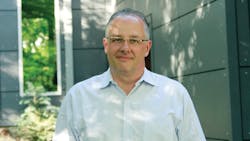Axel Schlumberger appears to have, in a manner of speaking, taken his work home every day for the past decade. While perhaps not literally true, Schlumberger, senior vice president for the energy division of wire and cable maker Southwire, has brought his energy industry awareness and core concepts — energy conservation and efficiency — into his Atlanta, Georgia, U.S., home since 2002.
Born and raised in southern Germany near Stuttgart, Schlumberger jokes that his chosen occupation felt almost predetermined. “Everybody around you is an engineer,” Schlumberger quips of his upbringing, adding that he chose electrical engineering, and a focus on energy in particular, even though it was a “counter-move to what was cool at the time.” In the 1990s, he explains, the engineering community was all about communications and consumer technology, but Schlumberger was always drawn to energy engineering.
Post-university, Schlumberger started as a sales engineer with a transmission cable company in Switzerland, then moved on to Southwire, which was just starting its move into the high-voltage transmission cable business. He and his wife Claire moved to the United States, and lived and worked near Southwire’s medium-/high-voltage manufacturing facility in Heflin, Alabama, for five years before he accepted a promotion to Southwire headquarters in Carrollton, Georgia, and the couple found their own special “dream house” (and now show house) on the west side of Atlanta.
“We bought a house that nobody wanted,” he begins. “It was a drafty, poorly insulated 1974 home with mediocre construction execution even for its time. They called it a California contemporary, a misfit in a traditional neighborhood.”
Schlumberger says, in fact, that his first interaction with a new neighbor included the query, “When are you going to tear this house down and rebuild?” Everyone assumed the house was bought for its lot, he says, while he and his wife made the decision based on what they saw in the future. “Realtors always say, ‘But this house has so much potential,’” Schlumberger observes. “I guess we believed that.”
Among the potential Schlumberger saw was to turn the house into a more energy-efficient dwelling. “Efficiency is doing the same or more with less. I always like to start with where can we save on the actual energy we use?”
Over the span of several years, the complete exoskeleton of the house has been updated. Dark, energy-absorbing and heat-transferring bitumen shingles on the roof were replaced with a light-grey seamed metal roof to help deflect the searing summer sun in Atlanta. Roof decking and old insulation in the attic and cathedral ceilings were replaced with open-cell polyurethane foam, and old leaking single-paned windows were replaced with fiberglass framed, double-paned argon-filled glass with low-emissivity glazing throughout.
The building envelope was rebuilt from the interior sheetrock out, insulated with densely packed fiber insulation, substantial sheathing and a membrane material that allows for the installation of a rainscreen. The membrane, he says, “provides for a tight building envelope, the key to energy efficiency and a healthy interior climate.” The rainscreen itself consists of 2-ft by 8-ft (0.6-m by 2.4-m) fiber-cement panels mounted off the wall with open seams, allowing for air to circulate.
Topped off with high-efficiency hybrid electric/gas HVAC systems, Schlumberger claims that energy consumption for heating and cooling has been reduced by 60% to 70%. Here, efficiency was translated into a much more comfortable house that uses less energy. “It is difficult to quantify how much of our budget went specifically toward energy efficiency, and we cannot expect a short-term payback, but when you are at it,
do it right.”
He also credits his European upbringing with pointing him in the direction of energy conservation. In Germany, Schlumberger notes, the culture is more attuned to energy conservation than the United States. “This is very ingrained in the German mind,” he observes. “They buy cars not only on looks or performance, but on how many grams of carbon dioxide they put out. Here, folks are setting their thermostats to 68 degrees in the summer and 74 in the winter, rather than the opposite.”
Schlumberger is happy to talk about energy conservation — and his house — to coworkers and friends, and hosted a Christmas party this past year for his staff. He and his wife agreed to add the house to an Atlanta-area tour of modern homes this year. Schlumberger was told to expect up to about 1,000 visitors over two days. While eager to show and explain the house’s energy-saving makeover, though, he says he was not exactly seeking the limelight.
“We are not about global warming or giving up our lifestyle,” Schlumberger says. “I am more of a private guy, and I am not selling anything. Let people have a look, and they may get inspired to build or renovate with energy conservation in mind. For every megawatt of renewables we install in this country, there is at least equal opportunity for energy efficiency.”
